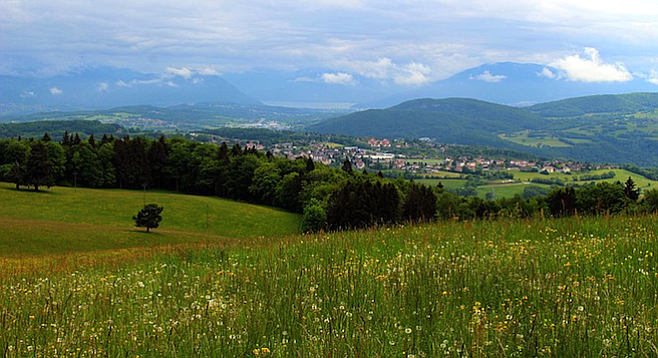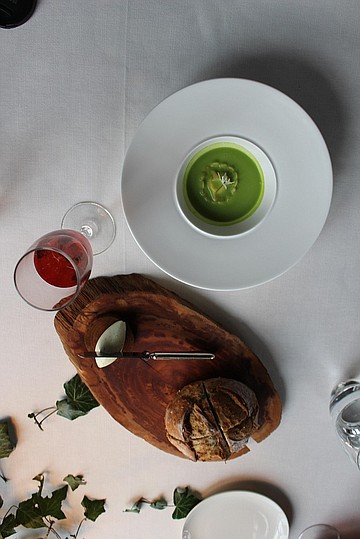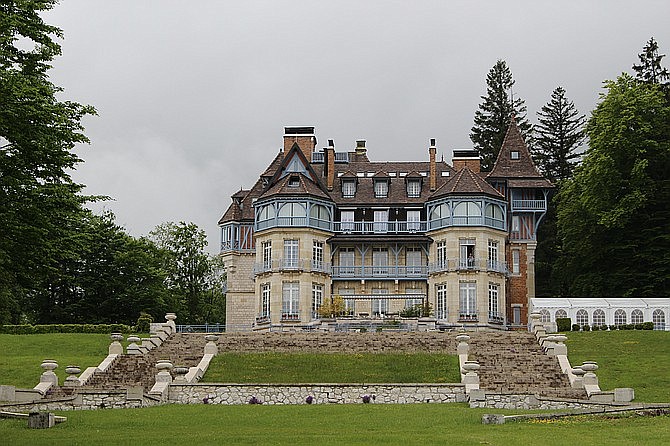 Facebook
Facebook
 X
X
 Instagram
Instagram
 TikTok
TikTok
 Youtube
Youtube

On a steep narrow country road 3,700 feet above sea level, my travel partner accelerated the engine, heading toward the sound of alpine bells. As herdsmen rallied the cows to graze on the undulating pastures of the Haute-Savoie, the early morning sun tinted the landscape ahead in soft hues. Beyond were the crystalline peaks of Mont Blanc.
It was the last week of May. Although the snow that once covered the summit of the Aravis ranges had melted, nearby Lake Annecy was still shaded in melancholy. Right below us were several wooden chalets that opened up to flower-brimmed meadows.
Had it rained that day, the drive would have been even more difficult; low-lying mists are known to mantle these highlands, and temperatures can drop rapidly. I thought of the days when pilgrims ascended these foothills – how brave they were to cross the perilous mountain passes on foot and without safety harnesses.
Unlike the monks, the nuns of the surrounding abbeys or the Hindu astronomer who visited Cruseilles before us on a quest for spiritual emancipation, we came to the Haute-Savoie region region in southeastern France simply to escape the maddening crowds of the glitzy French Riviera.
Although there are many ways to avoid the mob in late spring or early summer, I latched on to the idea of leaving the big city behind for a small village in cow country, reasoning that the long drive would an experience in itself. Certainly a more peaceful time awaits for those who make it here.
Arriving in Cruseilles, a small town in the Haute-Savoie, it was instantly apparent that we were no longer in sexy Saint Tropez or Nice. My travel partner and I were drawn to the town's simplicity and unpretentiousness.

Quite unlike the coveted Cote d’Azur, this part of the Haute-Savoie thrives on the beauty of snowcapped mountains and pine-scented countryside. Here is a different side of France. It’s a geographical point of intersection where three countries meet – and sometimes collide. To the east is Italy, to the south Savoie, with its imposing French Alps, and Switzerland to the north crossing Lake Leman (or Lake Geneva).
The Savoyards are known for their superior cheese and cured meat. Once you’ve fallen under the spell of the “typiquement Savoyard” lifestyle, it’s hard to resist the welcoming change.
So it was when Nicolas Odin, the convivial proprietor of Domaine des Avenières – a Relais and Chateaux property nestled in the mountainous outskirts between Annecy and Geneva – opened up his maison to escaping pilgrims like us.
“I have always loved to live here. Cruseilles might be somewhere in the middle of nowhere, but I grew up in this village and there’s nowhere else I can consider a place called home,” says Odin with his French accent while holding his wife Laurence’s hands.
Odin’s first childhood memories were of the Alps, green pastures, deep glacier beds, lakes, and an eerie 20th-century manor house sitting remotely on a knoll. It was the house that struck his curiosity: the austere weatherbeaten roofs, stone walls and brick chimneys, which at times were the only things visible when the fog came rolling in. Back then, children from the village avoided going near the “haunted house” (as they called it; but the house was not really haunted, just scary-looking). But not Odin.

Before long, after working at a restaurant in Paris and getting his helicopter pilot’s license, Odin embarked on a mission of restoring the old manor. He gained the approval of the council, and after a painstaking renovation opened the doors of Domaine des Avenières to guests looking to experience the Savoyard life.
That afternoon the sunny weather turned its back, and rainclouds raced across the horizon. Despite the approaching weather, I was intrigued by the thick pine forest of the Salève countryside that creeped up from behind the hotel, and decided to wander aimlessly, leaving my travel partner behind.
I started hiking up a small twisting trail through the woods, relishing the silence. After half an hour I'd heard only one passing car and a farm tractor.
Further ahead, my gaze caught a lovely sight of alpine-looking houses. Montbéliarde cows were happily grazing on the open pasture, oblivious to the cacophony of the clanky bells they wore around their neck. I grew to love it. Why not? It was far better than hearing old men swear as they clean up after their dog’s merde.
After a full spectrum of the Haute-Savoie landscape, up, down and around the hills, I headed back inside and went to see the chapel.
I was told it was built in honor of Mary Wallace Schillito’s sister and her Hindu husband. She, a well-heeled American traveler, fell in love with the region and decided to build a haven on the edge of the forest. Her husband, Assan Farid Dina, was an astronomer and contributed to the life of the little village of Cruseilles by financing electric programs and bringing safe drinking water to the nearby hamlets. The chapel held a golden mosaic where the zodiac, Kabbalah and Egyptian tarot interplayed against a manicured garden. Soon the rain started to pelt down.
Before my stomach could raise a complaint, my travel partner was at the dining table and finished chatting with the waiter. A minute later, drinks arrived: pink champagne, a zesty Apremont and velvety-tinged Mondeuse d’Arbin. Then crusty warm French bread, foie gras, steaming fresh water cod and so on.
There’s nothing quite as pleasant and surprising than the Savoyard cuisine on a quiet evening when all you hear is the hurling rain and the theatrical waiter saying “J’arrive!”


On a steep narrow country road 3,700 feet above sea level, my travel partner accelerated the engine, heading toward the sound of alpine bells. As herdsmen rallied the cows to graze on the undulating pastures of the Haute-Savoie, the early morning sun tinted the landscape ahead in soft hues. Beyond were the crystalline peaks of Mont Blanc.
It was the last week of May. Although the snow that once covered the summit of the Aravis ranges had melted, nearby Lake Annecy was still shaded in melancholy. Right below us were several wooden chalets that opened up to flower-brimmed meadows.
Had it rained that day, the drive would have been even more difficult; low-lying mists are known to mantle these highlands, and temperatures can drop rapidly. I thought of the days when pilgrims ascended these foothills – how brave they were to cross the perilous mountain passes on foot and without safety harnesses.
Unlike the monks, the nuns of the surrounding abbeys or the Hindu astronomer who visited Cruseilles before us on a quest for spiritual emancipation, we came to the Haute-Savoie region region in southeastern France simply to escape the maddening crowds of the glitzy French Riviera.
Although there are many ways to avoid the mob in late spring or early summer, I latched on to the idea of leaving the big city behind for a small village in cow country, reasoning that the long drive would an experience in itself. Certainly a more peaceful time awaits for those who make it here.
Arriving in Cruseilles, a small town in the Haute-Savoie, it was instantly apparent that we were no longer in sexy Saint Tropez or Nice. My travel partner and I were drawn to the town's simplicity and unpretentiousness.

Quite unlike the coveted Cote d’Azur, this part of the Haute-Savoie thrives on the beauty of snowcapped mountains and pine-scented countryside. Here is a different side of France. It’s a geographical point of intersection where three countries meet – and sometimes collide. To the east is Italy, to the south Savoie, with its imposing French Alps, and Switzerland to the north crossing Lake Leman (or Lake Geneva).
The Savoyards are known for their superior cheese and cured meat. Once you’ve fallen under the spell of the “typiquement Savoyard” lifestyle, it’s hard to resist the welcoming change.
So it was when Nicolas Odin, the convivial proprietor of Domaine des Avenières – a Relais and Chateaux property nestled in the mountainous outskirts between Annecy and Geneva – opened up his maison to escaping pilgrims like us.
“I have always loved to live here. Cruseilles might be somewhere in the middle of nowhere, but I grew up in this village and there’s nowhere else I can consider a place called home,” says Odin with his French accent while holding his wife Laurence’s hands.
Odin’s first childhood memories were of the Alps, green pastures, deep glacier beds, lakes, and an eerie 20th-century manor house sitting remotely on a knoll. It was the house that struck his curiosity: the austere weatherbeaten roofs, stone walls and brick chimneys, which at times were the only things visible when the fog came rolling in. Back then, children from the village avoided going near the “haunted house” (as they called it; but the house was not really haunted, just scary-looking). But not Odin.

Before long, after working at a restaurant in Paris and getting his helicopter pilot’s license, Odin embarked on a mission of restoring the old manor. He gained the approval of the council, and after a painstaking renovation opened the doors of Domaine des Avenières to guests looking to experience the Savoyard life.
That afternoon the sunny weather turned its back, and rainclouds raced across the horizon. Despite the approaching weather, I was intrigued by the thick pine forest of the Salève countryside that creeped up from behind the hotel, and decided to wander aimlessly, leaving my travel partner behind.
I started hiking up a small twisting trail through the woods, relishing the silence. After half an hour I'd heard only one passing car and a farm tractor.
Further ahead, my gaze caught a lovely sight of alpine-looking houses. Montbéliarde cows were happily grazing on the open pasture, oblivious to the cacophony of the clanky bells they wore around their neck. I grew to love it. Why not? It was far better than hearing old men swear as they clean up after their dog’s merde.
After a full spectrum of the Haute-Savoie landscape, up, down and around the hills, I headed back inside and went to see the chapel.
I was told it was built in honor of Mary Wallace Schillito’s sister and her Hindu husband. She, a well-heeled American traveler, fell in love with the region and decided to build a haven on the edge of the forest. Her husband, Assan Farid Dina, was an astronomer and contributed to the life of the little village of Cruseilles by financing electric programs and bringing safe drinking water to the nearby hamlets. The chapel held a golden mosaic where the zodiac, Kabbalah and Egyptian tarot interplayed against a manicured garden. Soon the rain started to pelt down.
Before my stomach could raise a complaint, my travel partner was at the dining table and finished chatting with the waiter. A minute later, drinks arrived: pink champagne, a zesty Apremont and velvety-tinged Mondeuse d’Arbin. Then crusty warm French bread, foie gras, steaming fresh water cod and so on.
There’s nothing quite as pleasant and surprising than the Savoyard cuisine on a quiet evening when all you hear is the hurling rain and the theatrical waiter saying “J’arrive!”
Comments